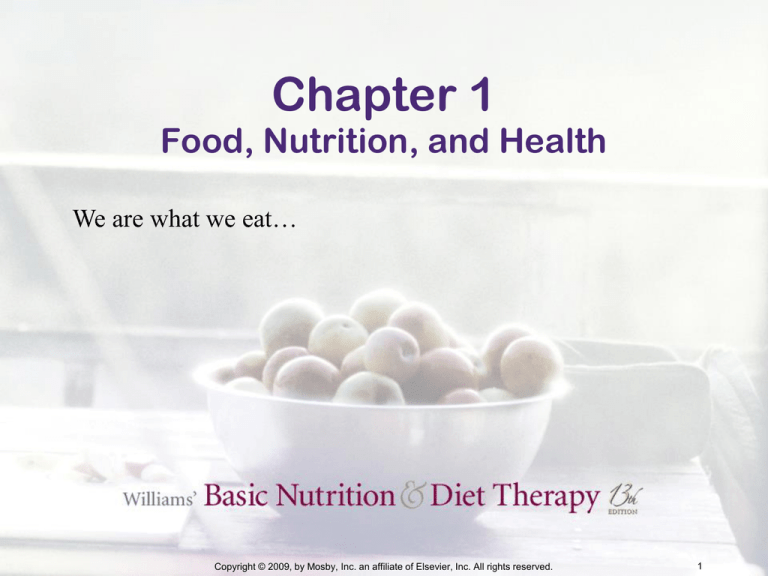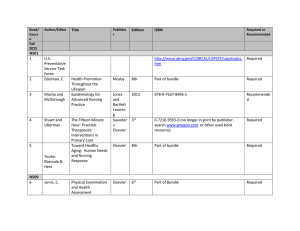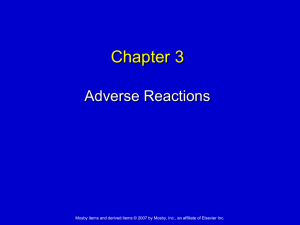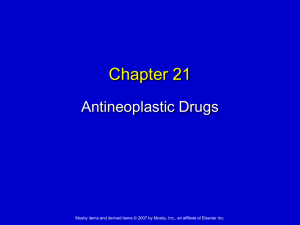
Chapter 1
Food, Nutrition, and Health
We are what we eat…
Copyright © 2009, by Mosby, Inc. an affiliate of Elsevier, Inc. All rights reserved.
1
Nutrition and Dietetics
• Nutrition
– Ingesting nutrients, restructuring them, and then
using them for our body’s benefit
– Food people eat and how the body uses it
• Nutrition science
– Scientific knowledge about food requirements
for human growth, development and
maintenance
Copyright © 2009, by Mosby, Inc. an affiliate of Elsevier, Inc. All rights reserved.
2
Nutrition and Dietetics, cont’d
• Registered Dietitian (RD)
– Nutrition authority on the health care team
– Other terminology
• Clinical nutrition specialist or public health
nutritionist (make sure RD is credentialed)
• Dietetics
– Field that applies nutrition science to human
health and assists in disease management
Copyright © 2009, by Mosby, Inc. an affiliate of Elsevier, Inc. All rights reserved.
3
Health and Wellness
• Proper nutrition is essential to good health which
includes meeting basic human needs
• Wellness seeks the full development of health
potential for all persons
• A balance between activities and goals
• Response to medical care system’s focus on
illness and disease
• The focus is on lifestyle and personal choices
Copyright © 2009, by Mosby, Inc. an affiliate of Elsevier, Inc. All rights reserved.
4
Healthy People 2010
• Encourages healthy choices in:
– Diet
– Weight control
– Decreasing risk factors for disease
HEALTHY PEOPLE 2020
• http://www.healthypeople.gov/2020/TopicsObjectives2020
/pdfs/HP2020_brochure_with_LHI_508.pdf
• 12 new topics added to Healthy
People 2010:
• Access to health care; oral health;
Clinical preventive services; tobacco;
environmental quality; injury & violence;
WIC health; mental health; nutrition,
physical activity, & obesity; reproductive
& sexual health; social determinants;
substance abuse.
Traditional and Preventive
Approaches to Health
• Traditional
– Attempts change only when illness or disease
already exists and has little value for lifelong
positive health
• Preventive
– Identifies risk factors and allows people to
choose behaviors to minimize risk of disease
Copyright © 2009, by Mosby, Inc. an affiliate of Elsevier, Inc. All rights reserved.
7
Signs of Proper Nutrition
•
•
•
•
Well-developed body
Ideal weight for body composition
Adequate muscle development
Smooth skin, glossy hair, clear and bright
eyes
• Mental and physical alertness
• Ability to resist disease
• Increased life span
Copyright © 2009, by Mosby, Inc. an affiliate of Elsevier, Inc. All rights reserved.
8
Nutrients in Food
•
•
•
•
Provide energy
Provide amino acids to build tissue
Regulate metabolic processes
Individual nutrients with specific
metabolic functions
• No nutrient ever works alone
– Iron & Vitamin C
– Calcium & Vitamin D
Copyright © 2009, by Mosby, Inc. an affiliate of Elsevier, Inc. All rights reserved.
9
Energy Sources
• Carbohydrates
– Primary source of fuel for heat and
energy
– Maintain body’s back-up store of quick
energy
– Should provide 45% to 65% of total
kilocalories
Copyright © 2009, by Mosby, Inc. an affiliate of Elsevier, Inc. All rights reserved.
10
Energy Sources, cont’d
• Fats
– Animal and plant sources
– Secondary (storage) form of heat and
energy
– Should provide no more than 20% to
35% of total kilocalories
Mosby items and derived items © 2006 by Mosby, Inc.
Copyright © 2009, by Mosby, Inc. an affiliate of Elsevier, Inc. All rights reserved.
11
Slide 11
Energy Sources, cont’d
• Proteins
– Primary function is tissue building and
repair
– Should provide 10% to 35% of total
kilocalories
– Source of energy when supply from
carbohydrates and fats is insufficient
Copyright © 2009, by Mosby, Inc. an affiliate of Elsevier, Inc. All rights reserved.
12
Tissue Building
• Proteins - provide amino acids
-Necessary for building and repairing tissues
• Vitamins and minerals
-Vitamin C for tissue building
-Calcium and phosphorus for building / maintaining bone
- Iron: Essential part of hemoglobin in the blood
• Fatty acids
-Build central fat substance of cell walls
Copyright © 2009, by Mosby, Inc. an affiliate of Elsevier, Inc. All rights reserved.
13
Regulation and Control
• Vitamins
– Function as coenzyme factors
• Components of cell enzymes in governing a
chemical reaction during cell metabolism
• Minerals
- Also serve as coenzyme factors
• Water
– Essential base for all metabolic processes
• Fiber
-Regulates passage of food material through
gastrointestinal tract
Copyright © 2009, by Mosby, Inc. an affiliate of Elsevier, Inc. All rights reserved.
14
Types of Nutrition Health
• Optimal nutrition
– Obtained from a varied and balanced diet
• Malnutrition
– Improper or insufficient diet
– Less than desired amounts of nutrients
– Limits work capacity, immune system function,
and mental activity
– Lack nutritional reserves for extra demand on
the body – illness, injury, or pregnancy
Copyright © 2009, by Mosby, Inc. an affiliate of Elsevier, Inc. All rights reserved.
15
Types of Nutrition Health,
cont’d
• Undernutrition
– Reserves depleted; Nutrient and energy intake
insufficient to meet daily needs/ metabolic
stresses
• Overnutrition
– Excess nutrient and energy intake over time
– Produces harmful total body weight
– Excessive amounts of nutrient supplements
over time resulting in toxicity
Copyright © 2009, by Mosby, Inc. an affiliate of Elsevier, Inc. All rights reserved.
16
Portion Distortion
Comparison of Portions and Calories 20 Years Ago to Present Day
20 Years Ago
Today
Portion
Calories Portion
Calories
Bagel
3'' diameter
140
6'' diameter
350
Cheeseburger
1
333
1
590
Spaghetti
w/meatballs
1 cup sauce
3 small
meatballs
500
2 cups sauce
3 large
meatballs
1,020
Soda
6.5 ounces
82
20 ounces
250
Blueberry
muffin
1.5 ounces
210
5 ounces
500
http://www.nhlbi.nih.gov/health/public/heart/obesity/wecan/eat-right/distortion.htm
Copyright © 2009, by Mosby, Inc. an affiliate of Elsevier, Inc. All rights reserved.
17
Dietary Reference Intakes
(DRIs)
• Published by the National Academy of Sciences
and updated every 5 to 10 years
• Includes recommendations for each gender and
age group for the minimum amount of nutrients to
protect majority of persons from the risk of
nutrient deficiency
• Encompasses four interconnected categories of
nutrient recommendations
Copyright © 2009, by Mosby, Inc. an affiliate of Elsevier, Inc. All rights reserved.
18
DRIs, cont’d
• Recommended Dietary Allowance (RDA)
– Daily intake of nutrients that meet
needs of almost all healthy individuals
• Estimated Average Requirement (EAR)
– Intake level that meets needs of half the
individuals in a specific group
Copyright © 2009, by Mosby, Inc. an affiliate of Elsevier, Inc. All rights reserved.
19
MyPyramid
• Food guidance system released 2005
• Valuable nutrition education tool for the
public
• Goal is to promote physical activity,
variety, proportionality, moderation,
and gradual improvements
• Moving toward My Plate as a better
visual aid for people
Copyright © 2009, by Mosby, Inc. an affiliate of Elsevier, Inc. All rights reserved.
20
MyPyramid / My Plate
Copyright © 2009, by Mosby, Inc. an affiliate of Elsevier, Inc. All rights reserved.
21
Dietary Guidelines for
Americans, 2005
• Established 1960s and updated every 5 yrs
• Based on nutrition choices to help prevent
chronic health problems of an aging
population
• Relate current scientific thinking to
America’s health problems
Copyright © 2009, by Mosby, Inc. an affiliate of Elsevier, Inc. All rights reserved.
22
Dietary Guidelines for
Americans – Focus Areas
• Nine focus areas
–
–
–
–
–
–
–
–
–
Adequate nutrients within calorie needs
Weight management
Physical activity
Food groups
Fats
Carbohydrates
Sodium and potassium
Alcoholic beverages
Food safety
Copyright © 2009, by Mosby, Inc. an affiliate of Elsevier, Inc. All rights reserved.
23
Changing Food Environment
• Heightened reliance on fast, processed,
or pre-packaged foods
• Surveys indicate malnutrition in U.S.,
however the outlook is changing:
– Fast food restaurants are beginning to offer
lower-fat, health-conscious alternatives
– Chain restaurants are developing new menu
items – oatmeal for breakfast
– Shoppers are using FDA’s nutrition labeling to
make better choices
Copyright © 2009, by Mosby, Inc. an affiliate of Elsevier, Inc. All rights reserved.
24
Summary
• Proper food and key nutrients are
essential to life and health
• Registered Dietitian is the nutrition expert
• Proper nutrition requires carbohydrate,
protein, fat, vitamins, minerals, and water
in the proper combinations
• Established nutrient and food guides for
health promotion
Copyright © 2009, by Mosby, Inc. an affiliate of Elsevier, Inc. All rights reserved.
25
Chapter 13
Community Food Supply and Health
“We think fast food is equivalent to pornography,
nutritionally speaking.” ~Steve Elbert
Copyright © 2009, by Mosby, Inc. an affiliate of Elsevier, Inc. All rights reserved.
26
Government Control
Agencies
• Food and Drug Administration (FDA) – primary
control of American food supply & quality
• USDA Food Safety and Inspection Service
(FSIS) – meat and poultry
• National Marine Fisheries Service (NMFS)- fish
• Environmental Protection Agency (EPA)
• Federal Trade Commission (FTC)
• Centers for Disease Control and Prevention
(CDC)
Copyright © 2009, by Mosby, Inc. an affiliate of Elsevier, Inc. All rights reserved.
27
Food and Drug Administration
• Enforces food sanitation and quality
control
• Controls food additives
• Regulates interstate food transport
• Maintains accurate nutrition labeling
• Ensures public food service safety
• Provides consumer education
• Performs research
Copyright © 2009, by Mosby, Inc. an affiliate of Elsevier, Inc. All rights reserved.
28
Food Labels
• Two types of label information
– Food standards: lists all ingredients
(“standard of identity”)
– Nutrition information: describes a
food’s nutritional value and percentage
of a 2000 Cal diet
Copyright © 2009, by Mosby, Inc. an affiliate of Elsevier, Inc. All rights reserved.
29
Current Food Label:
Nutrition Facts
Copyright © 2009, by Mosby, Inc. an affiliate of Elsevier, Inc. All rights reserved.
30
Food Label: Health Claims
• Strictly regulated by FDA for accuracy
• If claims make an association between a
food product and a specific disease:
– FDA must approve claim
– Food must meet criteria set forth for
that claim
– Wording on package must be approved
Copyright © 2009, by Mosby, Inc. an affiliate of Elsevier, Inc. All rights reserved.
31
Food Technology
• Agricultural and food processing industries have
developed chemicals to increase and preserve food
supply.
• Critics are concerned about how these changes
have affected food safety and the environment.
– Pesticides
– Food additives
Copyright © 2009, by Mosby, Inc. an affiliate of Elsevier, Inc. All rights reserved.
32
Agricultural Pesticides
• Goal is to increase food production for a growing
population
• Pros: Pesticides improve crop yields
– Example: Chemicals destroy many destructive
insects
• Cons:
– Pesticide residue on food
– Gradual leaching of chemicals into ground
water and wells
Copyright © 2009, by Mosby, Inc. an affiliate of Elsevier, Inc. All rights reserved.
33
Alternative Agriculture
• Organic farming
– Grow foods without synthetic pesticides, fertilizers,
sewage sludge, bioengineering, or ionizing
radiation
– Raise animals and produce dairy products without
antibiotics or growth hormones
– Use manure from organic animals to fertilize fields
• Natural pest control may be used – aphids, spiders,
bats
Copyright © 2009, by Mosby, Inc. an affiliate of Elsevier, Inc. All rights reserved.
34
Alternative Agriculture,
cont’d
• Genetic modification
– Reduces the need for toxic pesticides and
herbicides
– Example: Genetically modified corn that
expresses a protein that acts as an insecticide
– Seedless oranges, grapes and watermelons are
genetically modified.
Copyright © 2009, by Mosby, Inc. an affiliate of Elsevier, Inc. All rights reserved.
35
Alternative Agriculture,
cont’d
• Irradiation – used since 1960s
– Kills bacteria and parasites on food after harvest
– Prevents food-borne illness
– Can increase shelf life of produce
• Foods that are irradiated have:
– Unaltered nutritional value and are not radioactive
– No harmful substances introduced as a result of
irradiation
– May taste slightly different to some people
Copyright © 2009, by Mosby, Inc. an affiliate of Elsevier, Inc. All rights reserved.
36
Food Additives
• Chemicals intentionally added to foods to prevent
spoilage and extend shelf life
• Benefits include:
– Enriched food with added nutrients (sugar)
– Uniform quality of food
– Standardized functional factors (e.g., thickening)
– Preserves foods (ex: salt)
– Controls acidity and alkalinity to improve flavor
and texture
Copyright © 2009, by Mosby, Inc. an affiliate of Elsevier, Inc. All rights reserved.
37
Food-Borne Disease
• 76 million people in the United States sickened
with food-borne disease annually
• 325,000 U.S. hospitalizations annually
• $83 billion annually in medical costs and personal
salary losses
• Salmonella, Campylobacter, Shigella, and
Cryptosporidium
Copyright © 2009, by Mosby, Inc. an affiliate of Elsevier, Inc. All rights reserved.
38
Buying and Storing Food
• Food should be of good quality.
• Dry or cold storage is best.
• Refrigerate promptly at 40° F or lower. Food does
not need to cool before being placed in the
refrigerator.
• Do not cross-contaminate foods, wash hands and
counter surfaces.
• Cook to proper temperatures.
• Do not eat food that has been above 40° F for
more than 4 hours. (4x4 ‘rule’)
Copyright © 2009, by Mosby, Inc. an affiliate of Elsevier, Inc. All rights reserved.
39
Food Contamination
• Food-borne illness usually presents with flulike
symptoms
• High-risk individuals: Age & physical condition
– Young children
– Pregnant women
– Elderly
– Individuals with compromised immune systems
Copyright © 2009, by Mosby, Inc. an affiliate of Elsevier, Inc. All rights reserved.
40
Bacterial Food Infections
• Salmonellosis
– Caused by Salmonella, which grow
readily in milk, custard, egg dishes,
salad dressing, sandwich fillings,
seafood from polluted waters &
undercooked chicken
– Unsanitary food handling can spread
bacteria
Copyright © 2009, by Mosby, Inc. an affiliate of Elsevier, Inc. All rights reserved.
41
Bacterial Food Infections,
cont’d
• Shigellosis
– Caused by Shigella, which grow easily
in milk
– Most common in young children
– Usually confined to large intestine
Copyright © 2009, by Mosby, Inc. an affiliate of Elsevier, Inc. All rights reserved.
42
Bacterial Food Infections,
cont’d
• Listeriosis
– Caused by Listeria
– Grows in soft cheese, poultry, seafood,
raw milk, commercially broken and
refrigerated raw eggs, meat products
(such as pâté)
Copyright © 2009, by Mosby, Inc. an affiliate of Elsevier, Inc. All rights reserved.
43
Bacterial Food Poisoning,
cont’d
• Clostridial food poisoning
– From Clostridium perfringens and
Clostridium botulinum
– C. perfringens are widespread in
environment
– C. botulinum cause botulism (serious,
often fatal food poisoning)
Copyright © 2009, by Mosby, Inc. an affiliate of Elsevier, Inc. All rights reserved.
44
Viruses
• Viral infectious hepatitis
• Caused by fecal contamination of water,
milk, or food or by contaminated shellfish
from polluted waters
Copyright © 2009, by Mosby, Inc. an affiliate of Elsevier, Inc. All rights reserved.
45
Environmental Food
Contaminants
• Lead
– Sources include lead paint, airborne lead
particles, water from lead pipes
• Mercury
– Sources include fish from contaminated water
Copyright © 2009, by Mosby, Inc. an affiliate of Elsevier, Inc. All rights reserved.
46
Parasites
• Roundworms
– Example: Trichina worm found in pork
• Flatworms
– Example: Tapeworms in beef and pork
Do not eat undercooked pork or beef.
Copyright © 2009, by Mosby, Inc. an affiliate of Elsevier, Inc. All rights reserved.
47
Key Concept
• Poverty often prevents individuals and
families from having adequate access to
their surrounding community food supply
causing undernutrition.
• The World Food Summit works to
eliminate hunger and establish
sustainable food supplies by 2015.
Copyright © 2009, by Mosby, Inc. an affiliate of Elsevier, Inc. All rights reserved.
48
Food Needs and Costs
• Worldwide hunger and malnutrition
– Lack of sanitation
– Cultural inequality
– Overpopulation
– Economic and political structure / unrest
– Chronic food or nutrient shortages
• In the United States
– More than 11 million households defined
as “food insecure” in 2000
Copyright © 2009, by Mosby, Inc. an affiliate of Elsevier, Inc. All rights reserved.
49
Food Assistance Programs
• Commodity Supplemental Food Program
• Food Stamp Program
• Special Supplemental Food Program for Women,
Infants, and Children
• National School Lunch, Breakfast, and Special Milk
Program
• Nutrition Services Incentive Program
Copyright © 2009, by Mosby, Inc. an affiliate of Elsevier, Inc. All rights reserved.
50
Food Buying and Handling
• Plan ahead to control impulse buying. Eat before
you go food shopping!
• Buy wisely.
– Understand packaging, labels, brands, portion
yields, measures, and food values.
– Only buy in quantity if savings will be achieved.
• Store food safely.
• Cook food well.
Copyright © 2009, by Mosby, Inc. an affiliate of Elsevier, Inc. All rights reserved.
51
Summary
• Common public have concerns regarding the safety of
the community food supply center on the use of
pesticides and food additives.
• These substances have produced an abundant food
supply but have brought dangers and require control.
• The FDA is the main government agency established
to maintain control.
• The FDA also conducts activities related to areas such
as food safety, food labeling, food standards,
consumer education, and research.
Copyright © 2009, by Mosby, Inc. an affiliate of Elsevier, Inc. All rights reserved.
52
Summary, cont’d
• Numerous organisms can contaminate food and
cause food-borne illness.
– Bacteria
– Viruses
– Parasites
• Rigorous public health measures control
sanitation, food areas and personal hygiene of
workers.
• U.S. food assistance programs are available for
families under economic stress.
Copyright © 2009, by Mosby, Inc. an affiliate of Elsevier, Inc. All rights reserved.
53





